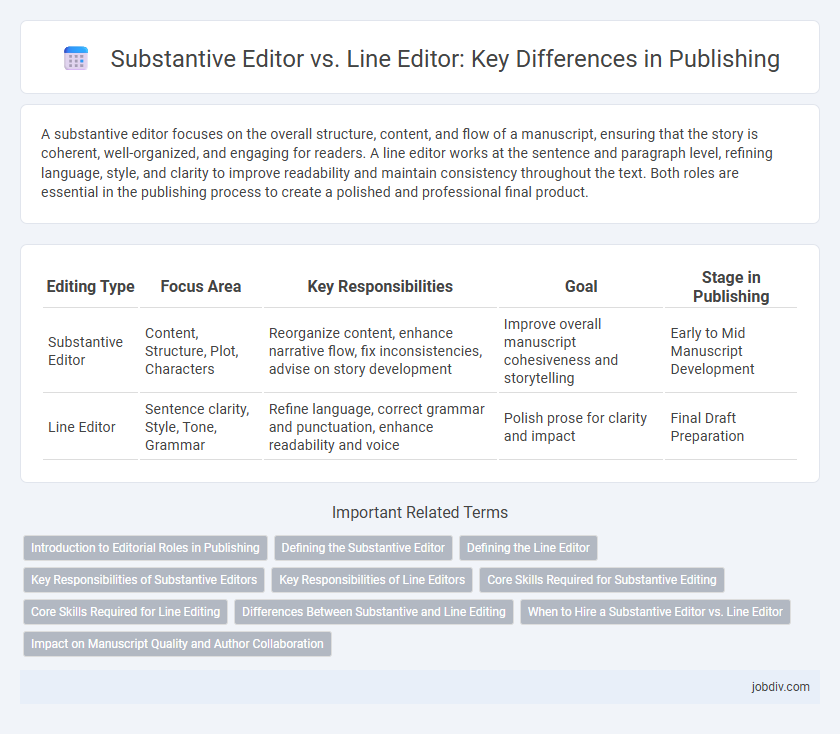A substantive editor focuses on the overall structure, content, and flow of a manuscript, ensuring that the story is coherent, well-organized, and engaging for readers. A line editor works at the sentence and paragraph level, refining language, style, and clarity to improve readability and maintain consistency throughout the text. Both roles are essential in the publishing process to create a polished and professional final product.
Table of Comparison
| Editing Type | Focus Area | Key Responsibilities | Goal | Stage in Publishing |
|---|---|---|---|---|
| Substantive Editor | Content, Structure, Plot, Characters | Reorganize content, enhance narrative flow, fix inconsistencies, advise on story development | Improve overall manuscript cohesiveness and storytelling | Early to Mid Manuscript Development |
| Line Editor | Sentence clarity, Style, Tone, Grammar | Refine language, correct grammar and punctuation, enhance readability and voice | Polish prose for clarity and impact | Final Draft Preparation |
Introduction to Editorial Roles in Publishing
Substantive editors focus on the overall structure, content, and clarity of a manuscript, ensuring coherence and logical flow across chapters or sections. Line editors concentrate on sentence-level improvements, enhancing style, tone, and readability while correcting grammar and syntax. Understanding the distinction between substantive and line editing is crucial for authors seeking comprehensive editorial support during the publishing process.
Defining the Substantive Editor
A Substantive Editor focuses on the overall structure, content, and clarity of a manuscript, ensuring that the narrative flows logically and that ideas are fully developed. They address major issues such as plot inconsistencies, character development, and thematic coherence to enhance the work's depth and readability. This role differs from a Line Editor, who concentrates on sentence-level improvements like grammar, style, and word choice.
Defining the Line Editor
A Line Editor focuses on refining the clarity, flow, and style of a manuscript by enhancing sentence structure, word choice, and consistency at the sentence and paragraph levels. Unlike a Substantive Editor who addresses overarching content, plot, and structural issues, the Line Editor ensures that language and tone align with the author's voice while polishing the text for readability and engagement. This role is critical in elevating the manuscript's polish before final proofreading and publication.
Key Responsibilities of Substantive Editors
Substantive editors focus on overall structure, content coherence, and narrative flow, ensuring manuscripts meet developmental goals and target audience needs. They identify gaps in plot, character development, and pacing, providing comprehensive feedback to improve the manuscript's foundational elements. Substantive editors collaborate closely with authors to reshape and enhance the core substance before finer details are addressed by line editors.
Key Responsibilities of Line Editors
Line editors focus on refining the sentence structure, grammar, and flow to ensure clarity and consistency throughout the manuscript. Their key responsibilities include enhancing word choice, correcting punctuation, and improving the narrative voice to maintain the author's intended tone. Unlike substantive editors who overhaul content and structure, line editors work closely on micro-level text details to polish the final draft for publication.
Core Skills Required for Substantive Editing
Substantive editors require strong analytical skills to assess manuscript structure, plot development, and character consistency, ensuring the overall narrative coherence. Proficiency in content organization and critical thinking enables these editors to identify gaps, redundancies, and logical inconsistencies, improving the manuscript's flow and readability. Expertise in genre conventions and audience expectations helps substantive editors guide authors in enhancing thematic depth and impactful storytelling.
Core Skills Required for Line Editing
Line editors require a keen eye for grammar, punctuation, and syntax to ensure clarity and consistency in the manuscript. Their core skills include understanding sentence structure, tone, and flow, enabling them to refine language without altering the author's voice. Mastery of style guides and attention to detail are essential for line editors to enhance readability and coherence at the sentence and paragraph levels.
Differences Between Substantive and Line Editing
Substantive editing involves a deep structural revision of a manuscript, focusing on plot development, character arcs, and overall organization to enhance narrative coherence and flow. Line editing targets sentence-level refinement, improving clarity, style, grammar, and word choice to ensure readability and polished prose. The primary difference lies in substantive editing addressing macro-level content and structural issues, while line editing fine-tunes micro-level language details.
When to Hire a Substantive Editor vs. Line Editor
Hire a substantive editor when your manuscript requires major structural revisions, such as reorganization of chapters, development of plot or argument, and enhancement of overall narrative flow. A line editor is essential when the draft is polished but needs attention to sentence clarity, tone consistency, grammar, and word choice. Choosing between a substantive editor and a line editor depends on whether the focus is on big-picture content improvement or detailed language refinement.
Impact on Manuscript Quality and Author Collaboration
Substantive editors enhance manuscript quality by restructuring content, improving narrative flow, and ensuring coherent argumentation, which significantly elevates the overall readability and impact of the publication. Line editors concentrate on sentence-level refinement, including grammar, punctuation, and style consistency, ensuring clarity and polish without altering the core content. Effective author collaboration differs as substantive editors engage in deep content discussions and developmental feedback, while line editors focus on detailed editorial notes and precise language adjustments, collectively fostering a manuscript's professional and polished final state.
Substantive Editor vs Line Editor Infographic

 jobdiv.com
jobdiv.com